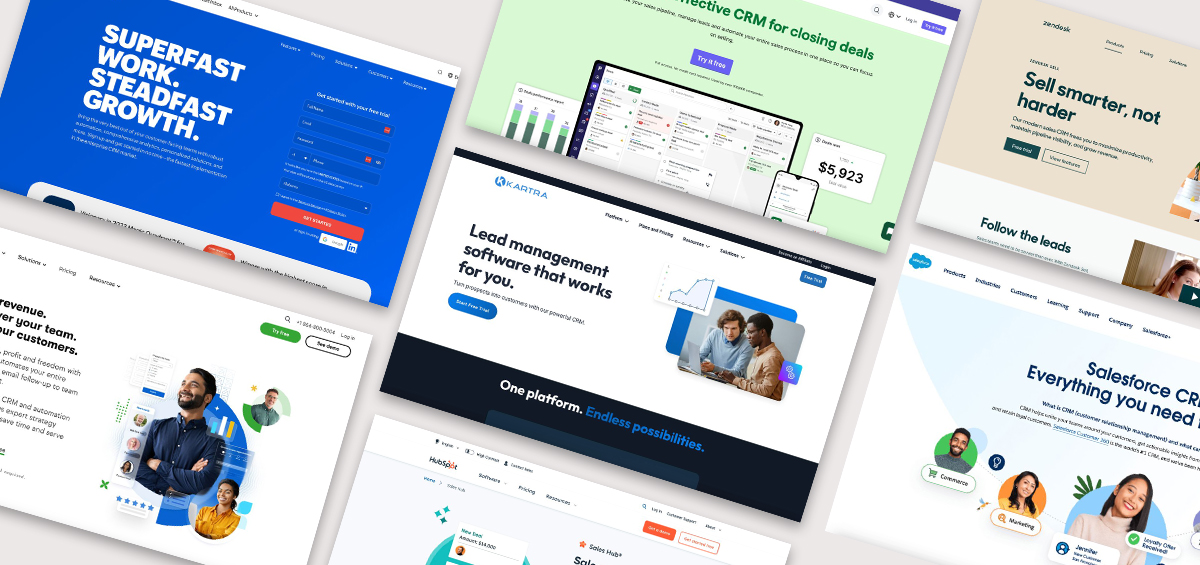You have a great idea for an online course — it’s something you’re passionate about and good at and you can tell there is demand for the course topic. But how do you actually make this vision a reality? This complete guide will walk through what you need to do to successfully create your first online course.
Set Objectives that Will Guide the Course
First things first, you will need to identify the specific goals you want the course to accomplish — for yourself and for your students. You probably already know many of the benefits of a particular course idea, but these objectives need to be as specific and measurable as possible.
Your Brand Goals
Online courses can serve many purposes within a brand.
Some content creators already have a thriving personal brand and an online course is the next step in monetizing their influence. For beginners who haven’t built a brand or sold anything online yet, a course represents an exciting opportunity to establish an online presence that will drive passive income.
What are your goals in creating this first course? Do you hope to create a lucrative side hustle from course sales? Do you want to create a mini-course that drives brand awareness for a new business? Having measurable objectives is critical to your success as an online course creator and should guide every step of the course development process.
Your Students’ Success
Before you dive into creating learning materials, write out the learning objectives for your students. What should they expect to know, or be able to do, by the end of your course? What will this knowledge accomplish in their lives? How do you intend to motivate them to complete the whole course?
This step requires you to have an in-depth understanding of your audience — including their background, their pain points, and their goals.
As an expert in your field, it may be tempting to share all you know about a particular topic. However, it’s important to craft your course with specific objectives that keep the learning experience honed in on the specific learning outcome.
Make sure these learning objectives are clear and measurable. Students need to understand exactly what value they will get from your course. Not only is this clarity helpful for the learners, but it also gives you a benchmark for knowing how to improve your course for the future.
Develop a Clear Course Roadmap
Outlining your whole course curriculum is essential to staying on track and reaching your objectives. You’ve established the purpose of the course – now you’ll need to develop a broad overview of each module and drill down into specific lesson plans as your course takes shape.
Start the roadmap by identifying where your students are when they begin your course and where they should be by the time they complete the course. With a starting point and an end goal set, you can begin figuring out the best journey for your students to take.
There is no one-size-fits-all outline for crafting online courses because they vary widely in purpose, subject matter, and length. But here are some questions to guide your outline at each organizational level:
- What are the learning objectives for this module/lesson?
- How do the learning objectives address a pain point or meet a need?
- What is the student’s current level of knowledge at this point in the course?
- How does this section of the course build on previous instruction?
- How does this section of the course lay a foundation for upcoming instruction?
- What activities will be most helpful to the student in this module/lesson?
- Should I include a knowledge assessment at this stage?
Keep in mind that this roadmap isn’t just for your benefit. Presenting this information to your students will help demonstrate the value of your course and keep students committed to finishing it.
Teaching vs. Application Content
As you plan the specifics of your course, think of each piece in terms of “teaching” content and “application” content. Teaching content is educational, introducing students to new information. Application content challenges students to take what they’ve learned and apply it practically in their lives. An online course must incorporate both teaching and application content to successfully meet learning objectives.
Our online learning experts recommend providing a program overview that lays out what students can expect during each stage of the course. It’s also a good idea to onboard new students with a starter guide that captures their interest and lays the foundation for the rest of the course.
Program Overview Example
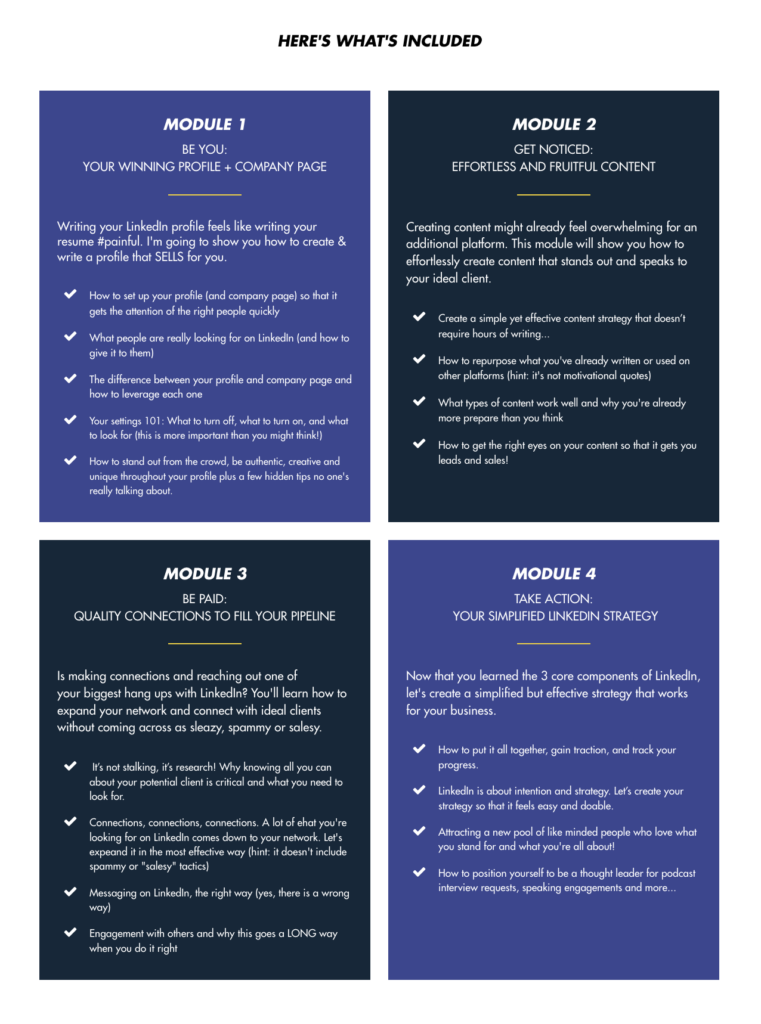
This program overview from Lindsay Mitrosilis’ LinkedIn Bootcamp breaks down each module to give students a clear picture of their journey through the course. Under each module, students can see the specific topics that will be covered and how that information will practically impact their lives.
Starter Guide Example
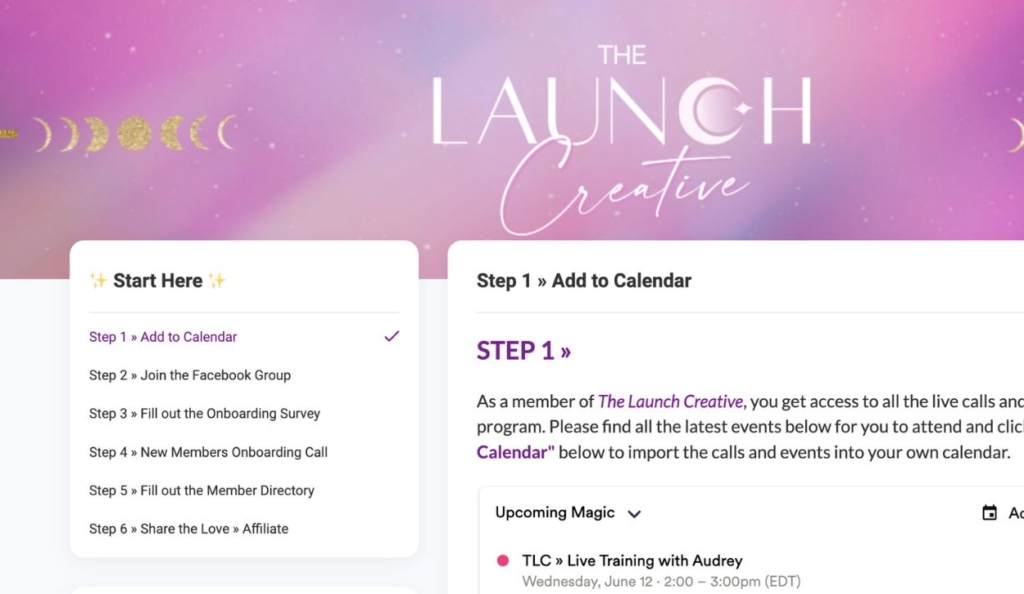
Course creator Audrey Rose welcomes new students to The Launch Creative with a step-by-step guide to getting started with her program. You could also present new students with a downloadable pdf that walks through introductory details, provides valuable information up front, and gives them a taste of what the rest of the course will be like.
Structure Your Course to Support the Learning Outcomes
There are many different ways to structure online courses — from live, bootcamp-style courses with groups of students to self-paced courses with DIY activities.
Focus on aligning your structure with learning outcomes. For instance, consider how to best cover the material so that students can both learn and apply the information.
Once you have a plan for the course structure, you can begin thinking through the best delivery mechanisms for the content. Some online courses are based on video lessons, while others take students through a workbook with activities or give students access to a library of downloadable content. Let the course structure and learning outcomes guide your choice of delivery methods — from broad categories (audio, visual, or text) to specific learning materials.
Incorporate Diverse Types of Learning Materials
Online learning experiences offer almost endless opportunities for customization. But don’t let that intimidate you. Successful online courses find a balance of giving students a high-quality experience while complementing the skills and personality of the instructor.
As you decide on the different delivery mechanisms for your course, remember that the course format needs to accomplish three main objectives:
- Deliver the course content in a way that is helpful and accessible to the students
- Keep learners motivated to finish the course
- Delight students and inspire them to share their experience
Here are some learning material ideas to consider:
Video Content
A popular choice for online education, videos allow subject matter experts to connect and engage with their students remotely. Videos can be live or recorded, depending on your course model, and take a variety of forms:
- Talking heads (recordings of the instructor)
- Screen recordings
- Voiceovers
Depending on the subject matter and lesson length, your course could be made up of in-depth video tutorials or webinars — or you can break up course content into short clips that motivate students with a sense of accomplishment. The important thing is that the videos align with the learning objectives for the module and keep students engaged regardless of length.

Video tutorial from online tennis coach and Kartra user Cosmin Miholca, of WebTennis24
Downloadable Assets
Downloadable resources play a similar role in a digital course as physical course materials do in an in-person course. That’s not to say that you can’t incorporate tangible course materials — you certainly can, and that’s a great way to connect with your students. But downloadable content such as ebooks, worksheets, templates, checklists, or infographics are indispensable resources for any online course.
These assets also give you a chance to reinforce your brand in the minds of your students. When writing and designing each resource, being consistent with your brand enhances professionalism and unifies the students’ learning experience.
Workbook Example
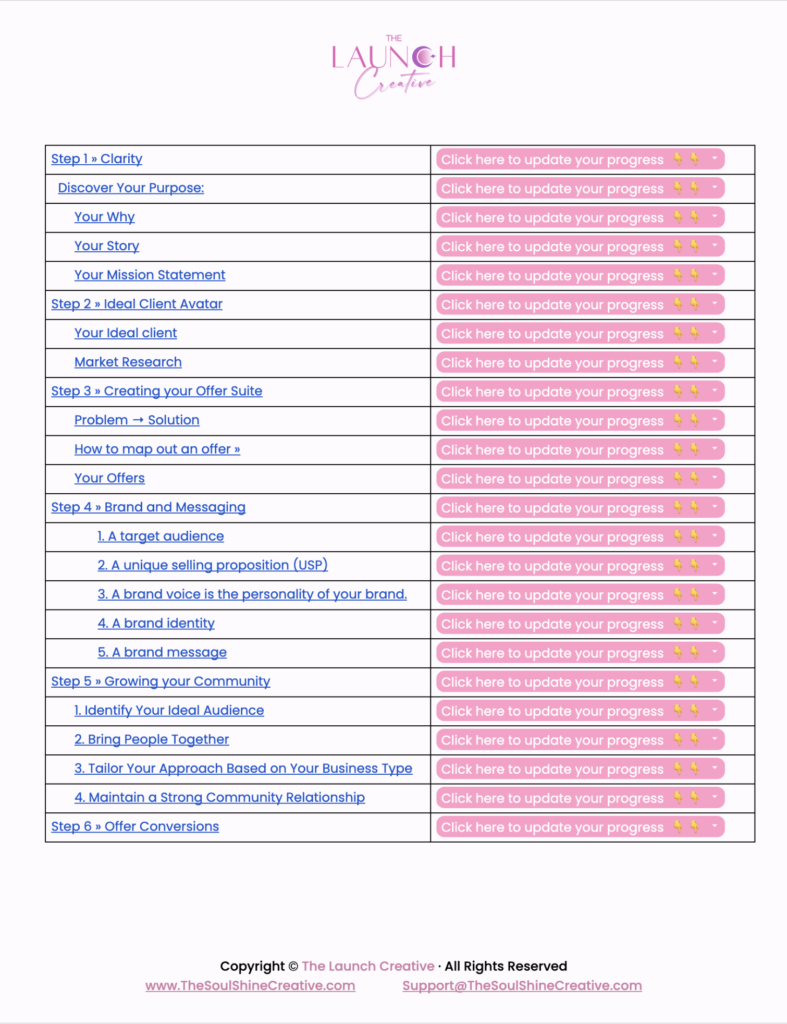
A workbook is a great tool for helping students apply the knowledge they’re learning in a practical way. Plus, it’s a resource they can return to as often as they need it — reminding them of the value and impact of your course. This workbook from The Launch Creative — run by Kartra user Audrey Rose — incorporates interactive elements so students can jump between sections and keep tabs on their progress.
Worksheet Example
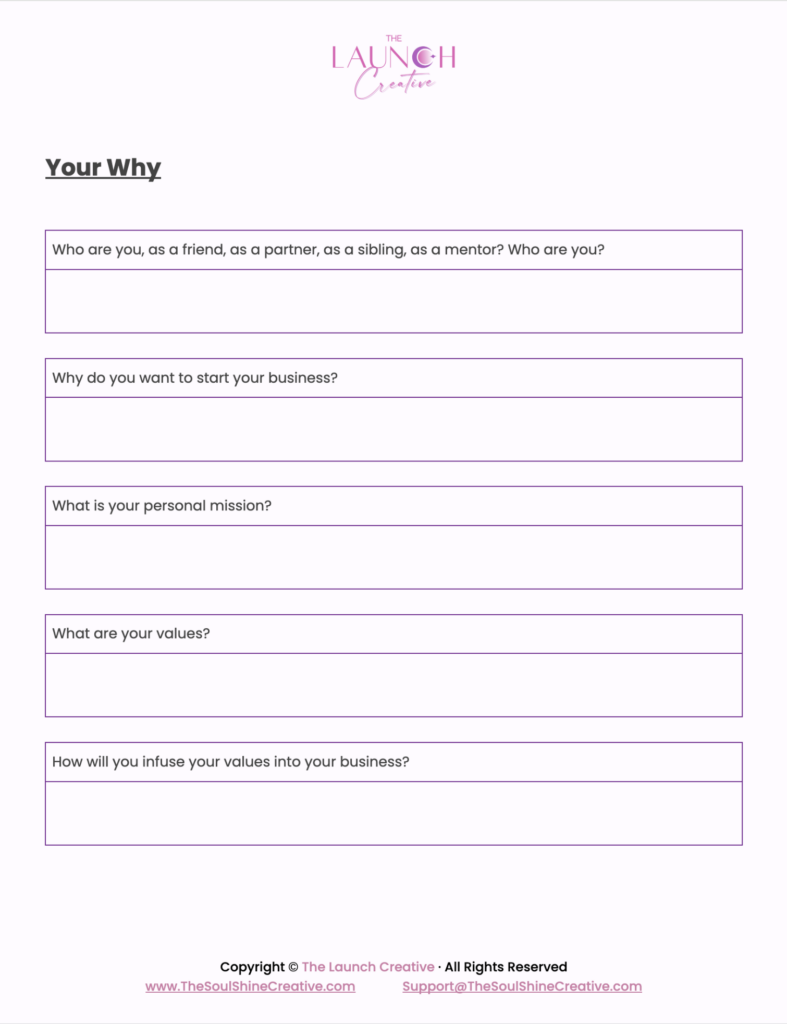
A fillable worksheet could be part of a larger workbook, like this example from The Launch Creative, or it could be a standalone asset that goes with a particular module or session. Either way, it’s a practical means of engaging students and challenging them to apply their knowledge.
Interactive Elements
Interactive components of your course are key for keeping students engaged. Much like a traditional class setting, learners are likely to tune out if they aren’t actively contributing to their education. Consider how you can capture students’ attention with items that require their participation:
- Surveys or assessments
- Quizzes or tests
- Live Q&A sessions
- Live lectures
- Discussion boards
Community Elements
Group activities foster a sense of community, encourage active participation, and give students added accountability for completing the course. Some course models naturally incorporate group dynamics, such as courses that educate cohorts of students during a designated time frame.
Courses that are self-paced are a little more challenging, but the principle still applies. People like to know that there are others who share their interests, goals, and experiences! Here are a few ways to build a community around your course:
- Create a private Facebook group or LinkedIn group
- Encourage friendly contests
- Incorporate group discussions or forums
- Give people shareable assets they can use to celebrate milestones or show group spirit (such as social media graphics or course merch)
Personalized Materials
One of the challenging aspects of an online learning experience is making each student feel seen. The good news is that there are endless opportunities for adding a personal touch. Remember a little effort goes a very long way.
Get creative and find ways to surprise and delight your students with unexpected touchpoints along their journey. With the right software, personalization can even be accomplished on a large scale. For example, if you have a good system for organizing contacts, it’s a simple step to have emails or physical mail customized with students’ names and other personal information.
Here are a few ideas to help you brainstorm:
- Personalized welcome emails
- Physical welcome letters
- Welcome packages
- Notes of encouragement
- Course merch — such as t-shirts, stickers, notebooks, or water bottles
Tip: Repurpose Course Content!
As you develop course materials, keep in mind that you can (and should) repurpose parts of your course to serve as lead magnets, giveaways, teasers, or other promotional content. It takes a lot of work to develop course modules, so take advantage of every opportunity to leverage the content you’re already creating!
For example, the course’s introductory lesson could be repurposed as teaser content for your social media accounts or offered as a downloadable course sample on your website.
And if you’re already a content creator, think about how you can use existing blogs, podcast episodes, videos, or posts in your course material to save yourself time and effort.
Find the Right Platform to Deliver Your Online Course
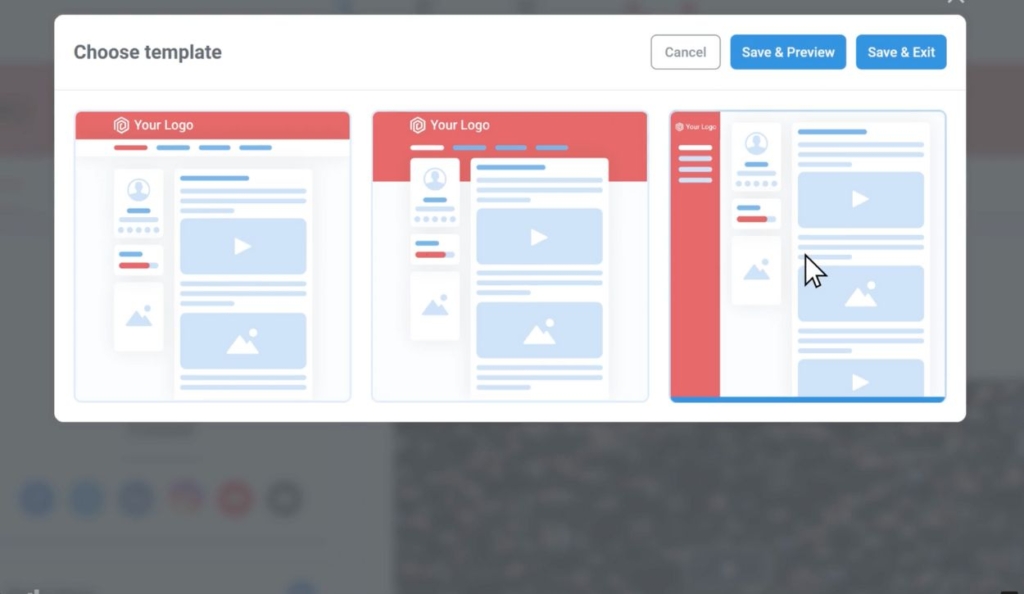
Creating and delivering your course will require an online course platform that gates course content behind a paywall on your website and allows you to create an interactive experience for your students.
With high-quality course software such as Kartra, it’s easy to set up a payment processor, upload course materials, and create membership tiers where paying customers only get access to the course materials that belong to their plan. You can even get access to digital marketing must-haves such as email marketing when you choose an all-in-one software like Kartra.
These are some of the key features and marketing tools to look for in an online course platform:
- Professional landing page and form builder
- Native video and webinar hosting
- Advanced email automation
- Automated workflows and sales funnels
- Affiliate marketing
- Data analytics
While it’s possible to find these features in individual software, a comprehensive course platform will minimize integrations and keep you from paying for multiple subscriptions.
Types of Course Publishing Platforms
There are three main types of course publishing platforms in the e-learning world:
An online course platform, as described above, gives content creators the most control over their products. Course software is designed for entrepreneurs who want to sell digital products and create a membership experience through their own website.
A massive open online course (MOOC) is an online course marketplace that educates large numbers of students on a wide range of subjects. Not intended for independent course creators, a MOOC is its own platform with its own member base. Educators upload either paid or free courses to these platforms for online learners to access.
A learning management system (LMS) is used primarily by schools or businesses to facilitate online classwork and training programs. It integrates more administrative tools than an online course platform and is not intended for independent course creators.
Work Out Any Issues with a Beta Test
Creating your first course can be an intimidating process. One step you can take to ease into launch day is to beta test your course. A beta test is a trial run where a select group of students go through your course and provide feedback and recommendations based on their experiences.
Beta testers could be contacts on your email list, people you’ve networked with on social media, or anyone who fits your target audience. Beta tests are often discounted or free in order to set the right expectations and incentivize enrollment.
This is a very helpful stage of launching a course, giving you time to fix any bugs and make improvements before the official course is released. It’s also a chance to optimize your sales page with FAQs, testimonials, and other social proof before launch day!
Remember the Bigger Picture
It’s easy to get lost in the weeds when planning and designing your online course—there are a lot of steps involved and decisions that you have to make. But don’t forget to take a step back and remember why you want to create this course in the first place!
At the end of the day, you’re excited about sharing your knowledge with others and growing your business in the process. Focus on bringing value to your students and don’t worry about getting it perfect — there’s time to hone your process and make improvements as you go.
Next on Your Online Course Creation Journey…
-> How to Price an Online Course: Steps and Strategies
-> How to Sell an Online Course: Make Money from Your Knowledge
-> How to Launch Your Online Course: A Step-by-Step Guide to Maximize Revenue
-> How to Market Your Online Course: Successfully Grow Your Business

